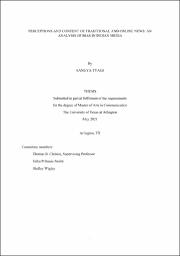
ATTENTION: The works hosted here are being migrated to a new repository that will consolidate resources, improve discoverability, and better show UTA's research impact on the global community. We will update authors as the migration progresses. Please see MavMatrix for more information.
Show simple item record
| dc.contributor.advisor | Christie, Thomas | |
| dc.creator | Tyagi, Sangya | |
| dc.date.accessioned | 2021-06-01T21:14:58Z | |
| dc.date.available | 2021-06-01T21:14:58Z | |
| dc.date.created | 2021-05 | |
| dc.date.issued | 2021-05-07 | |
| dc.date.submitted | May 2021 | |
| dc.identifier.uri | http://hdl.handle.net/10106/29838 | |
| dc.description.abstract | The primary objective of this study was to compare and analyse two different points of view on media polarization: one, from the public’s perspective through a survey (analysis of their perceptions on news received from their preferred news sources) and the other, analysis of media published by the media content providers. Another research contribution of this study was that it included an analysis of the mode of media consumption, i.e., how the news was consumed--via traditional media or through online media. This project ties in a variety of aspects in the field of communication -- media, mode of news consumption, who consumes it, and what perceptions of bias they develop.
For the first research question, a survey was used to collect the data about what the public thinks and perceives of the news that they consume through their preferred news sources. The survey had 330 respondents who consume news in an online and/or traditional format. Analysis from the study shows that in general, most respondents found slight bias in the news reporting of their preferred media sources. However, this difference was not found to be statistically significant. The results for the first research question also show us that there was no significant perceived bias noted on coverage of 10 key issues, except for one. The respondents reported that they saw significant levels of bias when getting news on the issue of corruption from their preferred media sources.
For the second research question, data from traditional and online media was collected for a period of 10 days from two traditional media sources -- The Times of India and The Hindustan Times, and two online media sources – FirstPost and The Scroll. This data was analysed through content analysis. Theme-based news coverage from online sources and front-page coverage from the traditional media sources were coded to reveal the tone of news pieces, which was measured as ‘indication of bias.’ Results from the analysis reveal that there was a significant difference in the tone of the news coverage when comparing traditional and online news sources.
One key research questions guiding this study examines a possible relationship between the media source and the level of perceived biases on some key issues. Another research question examines the differences in bias between online news sources and traditional media sources. | |
| dc.format.mimetype | application/pdf | |
| dc.language.iso | en_US | |
| dc.subject | Indian media | |
| dc.subject | Indian traditional media | |
| dc.subject | Indian online media | |
| dc.subject | Media bias | |
| dc.subject | Perceived polarization | |
| dc.title | PERCEPTIONS AND CONTENT OF TRADITIONAL AND ONLINE NEWS: AN ANALYSIS OF BIAS IN INDIAN MEDIA | |
| dc.type | Thesis | |
| dc.degree.department | Communication | |
| dc.degree.name | Master of Arts in Communications | |
| dc.date.updated | 2021-06-01T21:14:59Z | |
| thesis.degree.department | Communication | |
| thesis.degree.grantor | The University of Texas at Arlington | |
| thesis.degree.level | Masters | |
| thesis.degree.name | Master of Arts in Communications | |
| dc.type.material | text | |
Files in this item
- Name:
- TYAGI-THESIS-2021.pdf
- Size:
- 957.7Kb
- Format:
- PDF
This item appears in the following Collection(s)
Show simple item record


